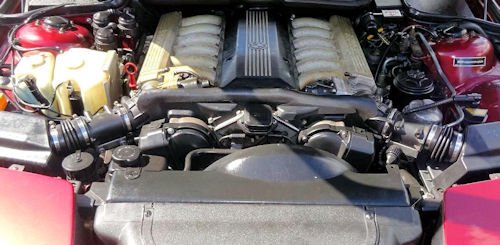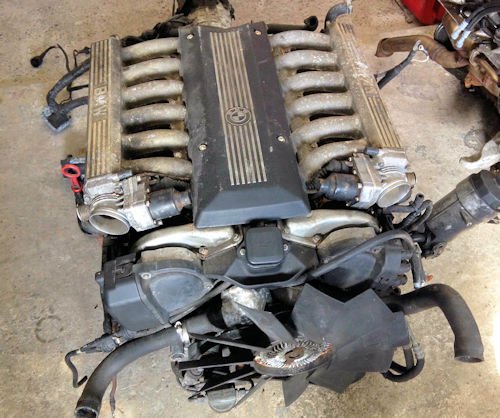BMW M70 V12 Engine
From 1987 to 1996

The BMW M70 is a V12 SOHC piston engine which was BMW's first production V12 and was produced from 1987 to 1996.
The BMW M70 is a 220 kW 12-cylinder V engine with a crankcase made of an aluminum - silicon alloy. The silicon should minimize wear. The bore is 84 mm, the piston stroke 75 mm, so that a total stroke of 4988 cm 3 results. Bore and stroke are the same as those of the M20B25 ; M20 and M70 have the same pistons. The pistons are made of an aluminum alloy and coated with iron, the piston recesses are aligned with the spark plug . The seven-bearing crankshaft , forged from C45E tempered steel, is like the BMW M21 stored in ternary bearings. There are always two connecting rods articulated on the same crank pin. The crankshaft has twelve counterweights.
Each cylinder has two valves, the valve plate of the inlet valve (diameter of 42 mm) is 44% larger than that of the outlet valve (diameter of 35 mm). The valves are actuated by rocker arms from an overhead seven-bearing camshaft , which is driven by a chain. For each cylinder bank, the engine has a camshaft ( SOHC ); because of the Pleuelanlenkung and cylinder position, the camshafts of the left and right cylinder bank are different lengths. Two digital engine electronics of the type Bosch Motronic 1.2individually regulate the intake manifold injection for each cylinder bank. The motronic systems are monitored by the electronic engine power control EML. The two throttle valves of the engine are synchronized with the EML control unit, which opens or closes the throttle valves according to the accelerator pedal position. In addition, the EML control unit also monitors the electronic driving aids. The ancillaries of the M70 are powered by a belt.
In principle, the M70 consists of two M20B25 six-cylinder engines, which share little more than the crankshaft and the return of the fuel in the tank, almost all other components are two-fold: fuel pump with flow, fuel pressure control, injection system with control units and exhaust system with one each separate strand, one catalyst each and independent lambda control. The redundancy goes so far that even one bank of the engine can run independently of the other in the emergency.
The M70 essentially acts as two 2.5L straight-6 engines joined at a 60 degree angle, and shares many design elements from BMW's earlier SOHC engine designs, most notably the M20. The M70 was machined on the same tools as the M40 straight-4 engine, and shares some common parts. Additionally, it carries over the same 84mm bore and bore spacing, 75mm crankshaft stroke and six cylinder bank(s) of the 2.5 litre M20. The M70 has two Motronic 1.7 ECUs (one for each cylinder bank).
This said, the M70 engine does differ from earlier designs in a number of key ways, including:
- AluSil block, in place of the cast-iron used in all previous engines. The oil pump is mounted on the block underside and not in the front timing cover.
- Mass Airflow Meters (MAF) are used instead of the more dated Air Flow Meter (AFM) design. The former is a more straight through design, similar to those employed in later BMW engines such as the I6M50, M52, and V8 M60, M62 etc. This gives a more responsive and accurate measurement than the older AFM style, aiding fuel economy
- Electronic Throttle Control is used in most markets instead of the cable setup common in other BMW engines until the later 1990s. For the most part this was surprisingly reliable system despite its complexity, particularly for the time. However issues with the DK throttle bodies is well documented
- A Timing Chain was used instead of the camshaft belt found in the M20 and M40.
- Hydraulic valve lifters are also used, rather than the mechanically adjusted tappets used in earlier engines including the M20. This was primarily due to ease of servicing. The M20 engines require tappets to be adjusted every 30,000 miles (50,000 km). However, due to the dual crossover banks on the M70, this would require removal of the intake manifolds to service.
- Some parts are interchangeable between the M40 and M70 - valves, rockers, tappets and connecting rods. Minimal parts are interchangeable between the M20 and M70 engines. Spark plugs, leads for the right bank, air filter (but not air box), and the late style front mount M20 distributor caps and rotors are all cross compatible with M70 engines, however virtually everything else is M70 V12 specific.
Some examples of this engine are fitted with two alternators, such as in the E32 750iL Highline. One alternator is a full sized unit to service the car as on "regular" V12 models (regular to be taken in context of course), while the secondary smaller unit is used to charge an auxiliary battery and power all options in the rear passenger compartment, such as telephones and fax machines, as well as the wine cooler, independent climate control and power sun shields.
The compression ratio is 8.8:1, stroke is 75 mm (3.0 in) and bore is 84 mm (3.3 in).
Technical data
| M70 | |
|---|---|
| engine type | 60 ° -V12 alloy engine |
| cooling | water cooling |
| valve control | OHC valve control , valves suspended at a 14 ° V angle, two per cylinder, actuated by an overhead camshaft via rocker arms |
| Engine control unit | Bosch Motronic 1.2 |
| mixture preparation | manifold injection |
| Bore × stroke | 84 mm × 75 mm |
| capacity | 4988 cm 3 |
| firing order | 1-7-5-11-3-9-6-12-2-8-4-10 |
| rated capacity | 220 kW at 5200 min -1 |
| maximum torque | 450 N · m at 4100 min -1 |
| Specific performance | 44.1 kW / dm 3 |
| Mean piston speed | 13 m / s |
| Maximum speed | 6000 ± 40 min -1 |
| Highest continuous speed | 5900 min -1 |
| Idle speed | 700 ± 50 min -1 |
| compression | 10-12 bar |
| compression ratio | 8.8: 1 |
| fuel | Unleaded 91-ROZ petrol |
| Dimensions | 240 kg |
| Capacity of the oil circuit | 7.5 l |
| engine | capacity | Valves / cyl. | Bore × stroke | compression | Power at 1 / min | Torque at 1 / min | construction time |
|---|---|---|---|---|---|---|---|
| S70B56 | 5576 cm 3 | 2 | 86 mm × 80 mm | 9.8: 1 | 280 kW (380 hp) at 5300 | 550 Nm at 4000 | 92-96 |
| S70 / 2 | 6064 cm 3 | 4 | 86 mm × 87 mm | 11.0: 1 | 461 kW (627 hp) at 7500 | 651 Nm at 5600 | 94-98 |
| S70 / 3 | 6064 cm 3 | 4 | 86 mm × 87 mm | 467 kW (635 hp) at 8000 | 670 Nm at 5000 | 94-98 | |
| D1 / 1 | 4988 cm 3 | 2 | 84 mm × 75 mm | 9.5: 1 | 257 kW (350 hp) at 5300 | 470 Nm at 4000 | 90-94 |
| D2 | 5646 cm 3 | 2 | 86 mm × 81 mm | 10.0: 1 | 306 kW (416 hp) at 5400 | 570 Nm at 4000 | 92-96 |

| Engine | Displacement | Power | Torque | Redline | Year |
|---|---|---|---|---|---|
| M70B50 | 4,988 cc (304 cu in) | 220 kW (300 hp) @ 5200 | 450 N·m (330 lb·ft) @ 4100 | 6000 | 1987 |
| S70B56 | 5,576 cc (340 cu in) | 280 kW (380 hp) @ 5300 | 550 N·m (410 lb·ft) @ 4000 | 1992 | |
| S70/2 | 6,064 cc (370 cu in) | 461 kW (618 hp) @ 7400 | 650 N·m (480 lb·ft) @ 6700 | 7500 | 1992 |
| S70/3 | 5,990 cc (366 cu in) | 448 kW (601 hp) @ 7500 | 651 N·m (480 lb·ft) @ 5600 | 7500 | 1997 |
M70B50
Applications:
- 1987–1994 E32 750i/750iL - this was mated exclusively an automatic ZF 4HP24 transmission
- 1989–1994 E31 850i/850Ci - this was mated to either the automatic ZF 4HP24 transmission or the optional Getrag 560G
S70B56
This is a 5,576 cc (340 cu in) variant of the M70 engine fitted only to the E31 850CSi. With 1,510 units produced, this is the lowest production BMW engine to date.
Applications:
- 1992–1996 E31 850CSi
S70/2
The S70/2, while sharing the same 12 cylinder layout and design principle as the S70B56, is essentially two European market S50s joined together, and thus features 4 valves per cylinder and variable valve timing (called dual-VANOS by BMW) a dry sump oiling system and individual throttle bodies. Unlike the M70, it does not have hydraulic valve lifters, and as such requires routine valve adjustment.
Applications:
- 1993–1998 McLaren F1
- 1998–1999 BMW V12 LM
- 1999–2000 BMW V12 LMR
- 2000 BMW X5 LM
Technical
-
Technical details and specifications BMW 8 Series (E31) 5,0 850i power 220 (299) @ 5200 1990-1993
No. of cylinders Type 12/OHC
Capacity 4988 cc
Compression ratio 8.8:1
Firing order 1-7-5-11-3-9-6-12-2-8-4-10.
Suitable for unleaded petrol Yes
Minimum octane rating 91 RON
Fuel System Type Motronic M1.2
Diagnostic socket Yes
Ignition coil Make Bosch Type 0 221 118 335
Fuel system pressure bar 2.94-3.06
Oil pressure bar 4.0 @ 5200 rpm
Radiator cap bar 2.0±0.1
Thermostat opens 80 °C
Starter motor Make Bosch Type 0 001 218 027
Minimum starting voltage 10 V
Maximum cranking amps 230-281 A
Alternator Make Bosch Type 0 120 468 032
Regulated voltage 12.5-14.2V
© Motor car History
